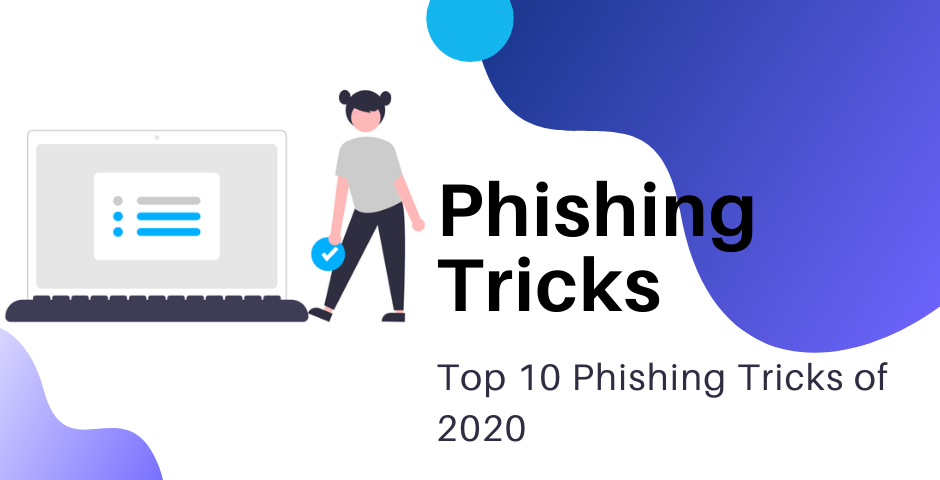Top 10 Phishing tricks of 2020

Hacking is an illegal act and is considered a cybercrime all over the world. This is one of the biggest treacheries that cybercriminals use to steal private or confidential information of users. Keeping up your guard regarding the cybersecurity has become one of the biggest, and toughest concerns for all the users around the world, and a fear-factor for the big organizations in particular.
Due to COVID-19, these cyber crimes have increased rapidly as well, posing some serious threats to businesses around the world. Thus, it is now the need for time to stay aware of such fraudulent activities. Phishing is one of the top cybercrime scams that are used to track the users and steal their information.
At times, friends use this trick to fool around as well and do not imagine the extent of consequences that they can cause. It is not only associated with banks but also your social media accounts. If you get an email that asks your confidential information, then do not share it. These attacks can have devastating effects on the individual and their private information.
Before diving into the top 10 Phishing tricks of 2020, lets first analyze what exactly is phishing, and what degree of it can be considered as illegal, or a crime.
Phishing can be referred to as the most simple and common technique that is used to steal sensitive information like password, username, bank credentials. In other words, it is a fraudulent attempt to obtain sensitive information by sharing an email or a cracked link, that pretend to look genuine or legitimate but isn’t.
The hacker sends an email that appears to be a trustworthy email from your bank that frightened you by some security threats. That email requires you to confirm your sensitive information by typing in a respective link. So, when a user types the information it directly goes to the sender. By this, your account can get hacked resulting in the loss of money.
Now, we will talk about phishing at the social media level. Suppose your friend wants you to open a link and tell you to like his/her Facebook page. When you open the link it requires you to log in details. When you put your username and password to log in, you got hacked. Because that information directly goes to your friend. So, this was phishing at a low level.
Now the second question that arises in our mind is: to what extent phishing is dangerous? As soon as it is concerned with a bank, phishing is a crime. One can get arrested for phishing. Because it is directly concerned with the money. The black hat hacker can withdraw all of your money easily if you fulfil his needs. And in the social media aspect, it is also dangerous and a crime but not at that level. It will only disclose your information but a hacker can not get to your money because social media accounts are not associated with your bank. Therefore, phishing is a crime and you should avoid it.
Lets now have a look at top 10 Phishing tricks of 2020, that have caused online theft of information.
- Spear phishing:
The traditional phishers use “spray and pray” techniques for phishing at a large scale. This means they send mass emails to as many people as possible, sending emails is called spray. Then they hope that may maximum people get into their trap, this is called pray. So, spray and pray is the largest used phishing terminology at this time. The hackers do not email the targeted person, because this may decrease their chances of hacking. They send emails to many people in general so, a large community can be targeted easily. When thousands of emails are being sent to thousands of people then most people consider it real and they easily fall into their trap. This is how phishing is being done on a large scale by black hats.
- Email/Spam:

Phishing is all about fake emails. But sending emails is also a talent. When millions of emails are being sent to millions of people in different regions then there are strong chances to hack people in at least thousands. Hackers send many types of emails with a different structure. Some of them ask to put credential data and some of them want the user to email back with sensitive information. Most commonly used emails ask to change details, update account information, or verify accounts. some of them may ask to fill a form to avail of new services from the bank by clicking on the link given in the email. Hence, emails are the basic tool require for phishing.
- Man in the middle technique:
Another sophisticated phishing technique is the man in the middle technique. It is also called web-based delivery. In this technique, the hacker is located in between the original website and the phishing system. This hacker act as a middle man between both legal and illegal systems. This is associated with the transaction process. When an account holder makes a transaction from his/her bank account to a legitimate website then the hacker steals all of his/ her account information without even getting noticed by the owner. In other words, when a user makes online transactions through a bank account to a website, the phishers gather all of his information. As the user continues to share the information, therefore, the hacker steals all the information without the user knowing about it.
- Link manipulation:

After email cracked links are the tools for phishing. In link manipulation, the hacker sends a link to a malicious website. When the user opens that link it opens the hacker’s website instead of opening the site mentioned in the deceptive link. When the user opens that link and goes on the phisher’s website then the phisher steals all of his information. This is how the link manipulation technique is used. At a lower level, link manipulation is associated with social media password hacks. When a user opens a link it requires his/her login details and by filling the log in captcha information directly goes to the hacker. These are two basic methods of link manipulation. There is a simple way to avoid this by hovering the mouse on the link to see the actual link address.
- Trojan: Its full name is a trojan horse. This phishing technique is also concerned with the trust breach. Almost all the phishing and hacking techniques are trust breaches, but this one is the actual misuse of someone’s trust. In trojan, horse hackers design a type of malware that mislead the user. There can be several kinds of designed malware for this purpose. This malware can be different in appearance but do the same work. They indulge the user to do an action that looks legitimate but in actual leads to unauthorized access to user’s personal information. When a user performs that specific action the hacker gets allowed to invade in credential information of the user. This is how the trojan horse works.
- Malvertising: Malware is a separate terminology of hacking. But malvertising is a technique in which phishing is used to operate malware terminology of hacking. In malvertising, malicious advertisements are used that contain active scripts. These active scripts are designed to download content on your computer. Once it has installed on the computer the hacker can easily control your computer and can steal information. Simply, malvertising uses advertising techniques to hack a system. They advertise software like games, editors, etc. This type of software includes cracked and hacked malware. When a user installs such software in the form of a game or editor then the hacker gets all the control of his/her computer. He may change the password and username or can manipulate information easily.
- Content injection:
Content injection is the use of a legitimate website to operate an illegitimate website. In content injection, the hacker modifies some data of a legitimate website and adds his content as a part of that page. It looks completely different from the original content of the website but looks interesting. When the user opens that data then it takes the user to the hacker’s website. Where a user needs to put his/her login details which are then used by the hacker. In simple words when you open a website you may find some part of other content that is not of that legitimate website. So, when you click to open that specific content you get into the trap and get hacked.
- Phishing through search engines:
Not even the search engines are safe from phishing. Many search engines have been used by hackers to steal credential information from the users. The most used technique on the search engine is trading. The user is directed to product sites, which offer high-quality products at low costs. There is a famous saying “greed is a curse”. When the user shows his interest in buying products, he is heading towards his destruction. When a user buys the product and for payment, he/she use his/her credit card, here he/she got hacked. When the user puts his credit card information it straightly goes to the black hats. Additionally, many fake bank websites offer credit cards or loans at low-interest rates. These are actual phishing websites.
- Vishing:
Another phishing trick is referred to as vishing. It is the mixture of voice phishing. It is also called voice phishing. In this technique, the hacker makes a phone call to the user asking his/her personal information. You must be thinking What is the need to change the voice? It is all about privacy, voices can be detected by cyber control authorities. Moreover, another main reason for vishing is trust. Because most of the people are now aware of email phishing and many people do not give any attention to such email. Therefore now hackers call the users as a bank representative and ask credential information. These caller IDs are fake and almost unable to track. They mislead the user by threatening them with some kind of security breach. Most of the users easily get trapped in their propaganda. - Smishing:
The phishing carried through short message service SMS is called smishing. After emails and calls, SMS is used to get credential information of the user. A smishing SMS demands credential information directly or by a link mentioned in the message. When a user opens that link it leads him/her to the phisher’s website where he/she became a victim of phishing
You can take the following steps in order to keep yourself safe from the Phishing tricks.
- Make sure to use two-factor authentication
- Awareness campaigns for your employees and personal use
- Use strong passwords
- Stay aware and mindful of such activities
- Always double-check the links before clicking them to make sure that it’s legitimate
- Always report the suspicious links or emails to your IT department
- Ensure that there aren’t any grammatical errors or illogical information in the emails
- Do not enter your personal information in the pop-up windows
- Implement the anti-phishing and takedown tools to monitor such activities in order to easily track them down
Conclusion
Hoping this article gave you sufficient idea regarding different tricks that can be used to steal your personal information. Thus, it is highly recommended that different prevention and protection strategies, and always stay extra vigilant regarding it. If you own a large scale business and are willing to keep your information safe from any element of threat, then you can also consider getting a phish kit or professional services like DDoS protected server
It must always be a priority to take all the possible measures to rule out any chances of cyber threats and keep your cybersecurity up to mark. Even the hackers have come up with more sophisticated ideas to steal passwords and information, thus you must double your efforts too.


